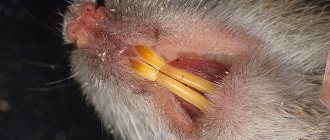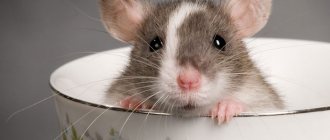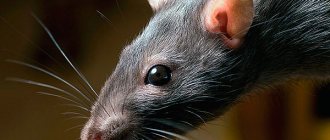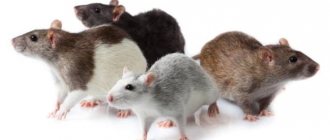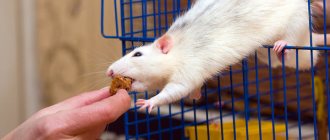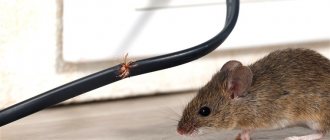Human attitudes towards rats are ambiguous. Some are afraid of them, citing the example of the Middle Ages, when the rat became the culprit of epidemics. Others hate them and try in every possible way to eradicate them. Others have not encountered them in life, so they are neutral towards them.
There is also a 4th category - people who keep this animal as a pet. It doesn't matter what category you fall into. Anyone can encounter this rodent, and the result of this encounter can be a rat bite. Then the question arises - what to do if bitten by a rat, what are the complications and consequences?
Briefly about rats
Rats have been known to mankind for a long time. In many writings about them there are negative lines, descriptions of terrible diseases that caused the death of hundreds, even thousands of people. Man has been fighting this unwanted neighbor for centuries, but its population is not decreasing. Their numbers increase every year, and the reason for this is the man himself, who arranges city dumps.
This is an excellent place of residence for rodents: here they arrange housing for colonies and find food for themselves.
Note! Every year, about 2 thousand people die from a bite. It is not the bite itself that is dangerous, but the diseases that can be transmitted through saliva.
Rodents are divided into 2 categories: domestic and wild. A domestic animal is rarely dangerous. They are bought in pet stores, where a veterinary permit or license is required. Then a person takes care of him: cleans the cage, feeds him, plays. Contact with wild representatives is kept to a minimum. Wild individuals settle in close proximity to humans:
- in city landfills;
- in the entrances;
- near trash cans in the yard;
- close to agricultural fields.
It is much less common to find an animal at home. They not only cause great discomfort with their proximity, but are also dangerous.
Carrying out deratization
Deratization is a set of procedures aimed at controlling rodents. They are exterminatory and preventive.
The goal of prevention is to prevent the appearance of rats in enterprises or premises. Typically, during prevention, the entry routes for animals and access to food are closed. It is also necessary to maintain the cleanliness of the premises, take out the garbage in a timely manner, and get rid of waste. You should not neglect the condition of waste accumulation areas and clean the area in a timely manner.
Read also: Chicken backs in a frying pan recipes
Extermination deratization is aimed at reducing the number of dangerous rodents and preventing their reproduction. This process is very complex and requires special training.
Specialists examine the risk zone and determine the degree to which a certain room is filled with rats.
After analyzing the territory, it is treated with special means. During the treatment, all workers or people living in the immediate vicinity must leave the premises and stay away from the cleaning area for a while. Only after complete weathering and assessment by a professional can you return to a clean place.
Deratization work is carried out mainly at large enterprises, factories, construction sites, agro-industrial zones, and places where waste accumulates. Preventive measures are also used in the educational sphere, nutrition and food sales.
When carrying out deratization, a specialist should be fully prepared. You must wear special clothing, gloves, a hat, a mask, and goggles. If a harmful substance gets in, you should immediately wash the affected area and treat the affected area.
Features of rat behavior
Rats are small animals with their own behavioral characteristics. Knowing them, you can minimize the risk of unwanted contact.
Reasons for attacks on people
This rodent, despite its close proximity to humans, prefers to avoid meeting him. An attack is possible if he feels hungry for a long time, but has nothing to eat. At risk are children, paralyzed patients, and adults who are heavily intoxicated by alcohol or drugs.
Note! A rat loses its sense of fear if it becomes infected with any viral disease. They become aggressive and stop hiding.
There are frequent cases of attack by an animal driven into a corner. Do not insist on playing with your pet if it has already refused once. Otherwise, the bite cannot be avoided. There are even known cases of rat bites in pet stores - they are under constant stress.
An adult female may show aggression if she sees that her offspring are in danger or the nest has been broken.
When rats bite
This animal rarely attacks first. But if, while next to him, you wave your arms or a stick, stomp, or perform other sudden actions, then he will take an attack pose. It looks like this:
- she stands on her hind legs;
- the body sways from side to side;
- a loud squeak is made, followed by an attack.
How a rat bites
The teeth of this rodent are quite long. They constantly sharpen them on all objects that come their way. In action are:
- crackers and other food products;
- paper;
- tree;
- plastic;
- concrete and other building materials.
Human skin is very thin, it is quite easy to bite through it. The greatest danger is posed by the lower incisors - they are sharp and long. More often they bite fingers, arms, and legs. A rat bite looks like puncture wounds that bleed.
Differences between rat bites and bites of other animals
Sometimes it can be difficult to distinguish a rat bite from another animal bite. The injury can occur while sleeping or on the street. Particularly difficult is an injury sustained by a child or animal.
In this case, you need to carefully examine the affected area. If you can see marks from the upper and lower incisors close to each other, then this is often evidence of a rodent bite.
It doesn’t really matter whether it was a mouse, a vole, or a hamster. They are all equally dangerous to humans.
Causes
To maintain good, friendly relationships, you should avoid situations in which the rat might bite.
- The pet was hurt;
- Scared;
- Hungry animal;
- The desire to attract attention.
Bites without a reason in domestic rats are practically excluded. If you squeeze an animal for a long time, then when it gets tired, it can gnaw lightly, thereby saying “enough.”
After preparing or eating food, you should also wash your hands thoroughly so that the smell of your fingers is not confused with food.
A rat may also bite another pet, such as a cat or dog. The reasons are the same - protecting one’s territory, fear, approaching danger. It happens that pets get along nicely next to each other and even play.
Any wounds sustained by pet rats should be treated, regardless of whether the bite was a human or a pet.
With a strong bite, the wound may not heal for a long time, especially in an animal when there is fur nearby, which constantly irritates the “battle wound.” Bites are painful, but by providing comfortable conditions for all family members to stay in the house, they can be avoided.
First aid to the victim
If you have been bitten by a rat, you should immediately begin preventive action. Take your time to stop the bleeding - most of the pathogens will come out with the blood. It is recommended to apply additional pressure to the wound to help the blood flow out.
Rodents have sharp, long teeth. They penetrate deep under the skin. The top layers are drawn in quite quickly and prevent complete cleaning.
Rat bite.
First of all, you need to wash the wound with laundry soap. Then it is recommended to treat with hydrogen peroxide, iodine or brilliant green. If the wound is deep, try to push the solution inside as much as possible using a bulb or syringe. Then a bandage with levomekol is applied. Doctors sometimes prescribe antibiotics as a medical treatment.
Treatment
If the first actions are taken quickly, the risk of possible complications is reduced.
Doctors can only conduct control tests and prescribe regenerative agents. In the case of a deep wound, you will have to go to the bandage until the inflamed area with blood clots begins to heal. How long healing takes place depends on the depth of the wound and timely primary care. If inflammation develops after a rat bite, the wound may take several months to heal. Shallow damage heals quickly, all that remains is to lubricate the abrasion with regenerating drugs - “Baneocin”, “D-panthenol”.
What is dangerous about a wild rat bite is the risk of contracting a dangerous infection. Tetanus and rabies are considered serious diseases from rat bites. One of the common symptoms of rat bites is sodocosis or rat fever. With this disease, bacterial anthropozoonosis develops. There are signs of general poisoning, lymphadenitis, dermatological rashes. Sodoku is a rat bite disease that is treatable if detected early. If a fever develops from a mouse or rat bite, primary surgical treatment is performed and the bitten person is administered penicillin antibiotics.
Vaccination against rat bites is indicated. They are vaccinated against tetanus; in some cases, vaccination against rabies is necessary with the additional administration of rabies immunoglobulin. In the future, the victim should be treated at home.
Possible consequences of rat bites
Abrasions, puncture and lacerations, hematomas, bruises are possible consequences of an encounter with a rodent. However, with well-planned treatment and care for the injury, the risk of complications is minimal.
Wound festering is the most common of these. The affected area is opened and drained. This complication can be avoided if you properly care for the wound. In advanced cases, soft tissue may be deeply affected, requiring amputation.
What infections do rats spread?
Rats have long been considered carriers of diseases, including viral ones. Of these, the most dangerous are the following:
- Sodoku is a rat bite disease that is fatal in 10% of known cases. It can be avoided if treatment is started on time;
- tetanus - the risk of death after infection reaches 20–30%. Tetanus ranks third among the most dangerous diseases after rabies and plague. Even after recovery, dangerous consequences are possible in the form of heart paralysis, pneumonia, sepsis;
- Leptospirosis is transmitted not only through saliva. If you notice that the animal has chewed the bread, then it is better not to eat it. The disease is dangerous due to paralysis, myocarditis, renal failure, infectious-toxic shock;
- pseudotuberculosis - dangerous for the development of meningitis, polyarthritis, osteomyelitis, myocarditis.
The risk of contracting rabies is minimal, however, it is a rather dangerous disease that requires prompt treatment.
Wound healing and factors influencing this process
The wound healing process can be disrupted by many factors.
Healing is the process of repairing damaged tissue and restoring its integrity. During the healing process, certain processes occur. We will not dwell on them in more detail, but will only indicate those factors that may disrupt the healing process:
- Age. As a rule, this applies more to older people. The child's body has great regenerative capabilities. This is due to the high level of anabolic (construction) processes in the body.
- Attachment of infection.
- Decreased immunity.
- Poor circulation in the wound area.
- Chronic diseases (diseases of the respiratory and cardiovascular systems, diabetes, tumors and others).
Healing complications
- Attachment of infection . Most often, a nonspecific purulent infection develops. The threat is tetanus, rabies, diphtheria. Therefore, injuries that have been bitten and contaminated with soil or old metal objects should be immediately examined by a surgeon with a number of preventive measures taken (administration of anti-tetanus serum, rabies vaccine).
- Bleeding.
- Divergence of defect edges.
- In some cases, healing may be complicated by a hypertrophic scar or keloid . They are an abnormal scar that can spread beyond the defect area and also contribute to the development of complications.
First actions after a rat bite
If you are bitten by a rat, do not panic. By adhering to a clear algorithm of actions, you can avoid harmful consequences.
- Rinse the wound under running water and then treat it with an antiseptic. Hydrogen peroxide, chlorhexidine, Miramistin, iodine or brilliant green are suitable for this. Don't wait for the bleeding to stop. The bites are usually deep and bleed for a long time.
- To avoid dirt getting into the wound and other mechanical damage, the affected area is bandaged.
- Observe the wound, and if you have the slightest doubt, consult a doctor.
It would be a good idea to get a preventive vaccination against rabies and other diseases, which will be offered at the nearest emergency room. Saliva is a breeding ground for bacteria and viruses.
What to do after being bitten by a pet rat
Pets are not considered carriers of diseases. However, if there is a wound, it is necessary to provide first aid to the victim and treat it thoroughly.
Change the dressings regularly and continue to treat the wound until it heals. If your health worsens, then this is a reason to contact a medical facility.
What to do if rats bite children in kindergarten
If a child, coming from kindergarten, complains that he was bitten by a rat, then not only therapeutic measures should be taken. Such a violation of the Sanitary Rules and Norms is an administrative offense.
Note! The teacher is obliged to monitor not only the children under his care, but also the order. Such a complaint requires contacting the Administration. If the problem is not resolved, then parents should write a complaint to the Sanitary and Epidemiological Service requesting an inspection. It is better to draw up a collective appeal, and attach to it copies of certificates from the health care facility where the doctor examined the injury.
Are bites from decorative rats and animals in pet stores dangerous?
If you are bitten by a pet rat or injured in a pet store, do not panic. Pets rarely show aggression. Most likely, they will not even bite through the skin. However, if the wound still bleeds, then it must be treated to avoid suppuration.
Also, pets and pet store animals are rarely carriers of dangerous infectious diseases.
What is rabies?
Rabies (or rabies, from the Latin word rabies, hydrophobia, fear of water) is an acute infectious disease resulting from the bite of a dog or other infected animal, which is characterized by severe damage to the nervous system and usually ends in death.
The danger of rabies was known in ancient times, but there were no treatment methods, and every victim was doomed to death.
Only the great French scientist Louis Pasteur managed to create a vaccine against rabies (rabies vaccine) in 1885. On July 6, 1885, he saved the life of a 15-year-old teenager who was bitten by a rabid dog.
How does rabies become infected?
The causative agent of rabies is the Neuroiyctes rabid virus, which contains a single strand of RNA. The virus is resistant to freezing, antibiotics and phenol, drying, and direct sunlight. Destroyed by heat, acids and alkalis.
When a dog (or other animal) bites, infection occurs as a result of saliva from a rabid animal entering the wound. Once under the skin, the rabies virus quickly reaches the central and peripheral nervous systems. The rate of spread of the disease depends on the location of the wound (the higher the bite site, the faster the infection), the depth and size of the wound, and the reactogenicity of the human body (i.e., the susceptibility of the nervous system to a given pathogen).
1 Dog bite. First aid
2 Dog bite. First aid
3 Dog bite. First aid
Symptoms of rabies
The incubation period lasts from 1 to 3 months (sometimes from 12 days to a year). The speed of spread is influenced by the location of the bite.
There are 3 stages of the disease: initial (depression), stage of excitement, stage of paralysis.
If a rat bites your pet
An adult pet rarely needs help when treating a wound. They themselves carefully lick the wound. The saliva of cats and dogs contains an enzyme that acts like an antiseptic. Only rare supervision is required on the part of the owner.
If a young pet is bitten, regular antiseptic treatment and bandaging will be required.
If the owner notices a change in the behavior or activity of the animal, then a veterinarian should be called. Many diseases require emergency specialist care. You should not make decisions or prescribe medications on your own.
How to protect yourself from attack
To protect yourself and your loved ones from rat bites, you need to monitor the sanitary condition of your living space. If a concentration of animals is found in another place, special services should be called to destroy pests and prevent attacks on people.
You also need to know the reasons for the attack. If an animal is scared, you should not show aggression towards it. You should leave this place and not disturb the rodent.
A rat may also attack if it is infected with rabies. In this case, when you see a wild animal, you must immediately leave and inform special services.
It is also forbidden to touch a mouse brought by a cat.
Your pet should be checked periodically by a veterinarian and up to date with required vaccinations.
It is not recommended to pet someone's rodent, as it may react aggressively to a stranger.
What symptoms indicate infection?
The incubation period for most diseases ranges from several days to a couple of weeks. Characteristic symptoms of infection:
- elevated temperature;
- chills;
- feeling of weakness;
- gastrointestinal disorders, namely vomiting, diarrhea, lack of appetite, abdominal pain;
- pain in the bite area, suppuration;
- uncontrolled muscle contractions;
- insomnia.
If you notice similar symptoms, consult your doctor for a diagnosis. It is important to tell the doctor when the bite occurred. This is the main difficulty: by the time they go to a medical facility, patients forget about the injury received from the rodent.
Prevention and precautions
To prevent rat bites, you must take the following precautions:
- it is forbidden to touch rats (even dead ones brought by cats);
- Do not visit rodent habitats (basements, underground sewers, cellars, landfills, construction sites);
- Be careful near fields and ponds;
- You should not pet an aggressive pet rat. A rodent can be calmed by splashing cold water on the animal;
- a pet rat requires vaccination and regular veterinary examination;
- If you cannot avoid meeting a rat, you should not provoke it to attack (try to make contact, drive it into a corner, move sharply).
A rat bite is a serious reason to seek medical attention. But even a professional doctor will not be able to help a person if treatment is delayed. Therefore, you definitely need to know what to do when attacked by rodents and how to provide first aid.

